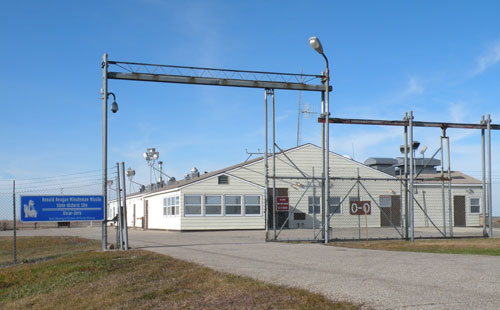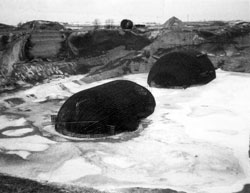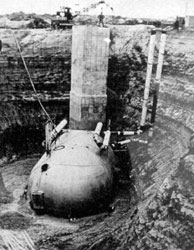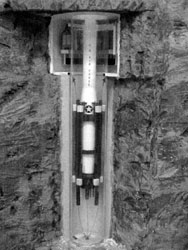The Ronald Reagan Minuteman Missile State Historic Site near Cooperstown served an important role as part of the United States’ strategy of nuclear deterrence during the Cold War years. The confrontation between the United States and the Union of Soviet Socialist Republics (U.S.S.R.) put our military on continuous alert. The U.S. Air Force started deploying solid-fuel Minuteman missiles near bases in Montana, Missouri, Wyoming, and the Dakotas in the 1960s.
Directly on the front lines of the Cold War, the Ronald Reagan Minuteman Missile State Historic Site preserves and interprets the story of the Minuteman missile system as well as the people working in and living around the missile sites. Constructed as part of the Grand Forks Air Force Base’s 321 Missile Wing, the Oscar-Zero Missile Alert Facility (MAF) and the November-33 Launch Facility (LF) were completed in 1965, with Minuteman II missiles installed shortly after completion.

The Oscar-Zero MAF consists of an above-ground Launch Control Support Building (LCSB) that housed an eight-person security and maintenance team and provided access to the underground Launch Control Center (LCC). Each LCC housed a two-person crew that was responsible for monitoring, launching, and retargeting its flight of ten nuclear missiles. Each LCC was linked by means of underground cables and a radio network to ten LFs in its flight and other LCCs in its squadron.
Missileers worked twenty-four hour shifts, called “alerts” every three days, averaging eight alerts per month. The two-member crews monitored the missiles and awaited orders twenty-four hours a day, seven days a week, 365 days a year.
 Support personnel remained topside, in the LCSB. Two two-person security teams were on duty day and night. A flight security controller coordinated response to alarms at the remote LFs as well as controlling the security of, and permitting access to, the MAFs. Along with these security forces, there was also a facility manager on site, responsible for the care of the entire MAF. A chef singlehandedly fed hungry team members several times a day as well as visitors such as the large maintenance teams or high-ranking officers.
Support personnel remained topside, in the LCSB. Two two-person security teams were on duty day and night. A flight security controller coordinated response to alarms at the remote LFs as well as controlling the security of, and permitting access to, the MAFs. Along with these security forces, there was also a facility manager on site, responsible for the care of the entire MAF. A chef singlehandedly fed hungry team members several times a day as well as visitors such as the large maintenance teams or high-ranking officers.
Many maintenance teams serviced the sites. Electro-mechanical teams, missile maintenance teams, missile handling teams, communication teams, civilian contractors and many other teams regularly moved throughout the missile sites.
The blast-hardened complex approximately fifty feet below the building consists of both the LCC and a Launch Control Equipment Building (LCEB). The underground steel-reinforced concrete LCC contains equipment for monitoring and launching the ten missiles. It also contains life support equipment and minimal accommodations for two duty officers. The LCEB provides environmental control and power to the LCC. The LCC and LCEB are protected by massive blast doors and were designed to be self-sufficient over prolonged periods, such as during a nuclear attack.
 November-33 LF was a self-contained underground concrete-lined steel missile silo with blast doors, an associated launch equipment room, and an adjacent underground launch facility equipment room. The LF was decommissioned, the missile was removed, and the silo was filled in as a result of the Strategic Arms Reduction Treaty (START) of 1991. Today, the site includes the above-ground concrete blast door that originally covered the missile in its silo. In the event of a launch, the door would be blown off the silo by sliding horizontally along rails, which are still in place. The access hatch for crews to service the missile is still there, and the whole site is surrounded by the original eight-foot security fence. The electronic surveillance system is also still in place.
November-33 LF was a self-contained underground concrete-lined steel missile silo with blast doors, an associated launch equipment room, and an adjacent underground launch facility equipment room. The LF was decommissioned, the missile was removed, and the silo was filled in as a result of the Strategic Arms Reduction Treaty (START) of 1991. Today, the site includes the above-ground concrete blast door that originally covered the missile in its silo. In the event of a launch, the door would be blown off the silo by sliding horizontally along rails, which are still in place. The access hatch for crews to service the missile is still there, and the whole site is surrounded by the original eight-foot security fence. The electronic surveillance system is also still in place.
For nearly thirty years these two missile facilities were on continuous alert. While the Cold War did not escalate into a full-scale shooting war, the U.S. continued to develop and stockpile increasingly sophisticated weapons. The single-warhead Minuteman II missile at November-33 LF and those controlled by Oscar-Zero MAF were replaced in the early 1970s by the new Minuteman III, which had greater range and could deliver three warheads to widely scattered targets.
 Following a dramatic arms race in the early 1980s, the Cold War showed signs of concluding with the fall of the Berlin Wall and the collapse of Soviet-Bloc countries in Eastern Europe. START, signed by the United States and the Soviet Union in 1991, occurred just before the collapse of the U.S.S.R. itself. START limited the number of strategic weapons on both sides, eventually resulting in the closing of the 321 Wing at Grand Forks AFB and the removal of all Minuteman missiles from the base. Each LF and MAF was dynamited or filled, except Oscar Zero MAF, which was preserved by the U.S. Air Force to become a state historic site in 2007. It is now on the National Register of Historic Places.
Following a dramatic arms race in the early 1980s, the Cold War showed signs of concluding with the fall of the Berlin Wall and the collapse of Soviet-Bloc countries in Eastern Europe. START, signed by the United States and the Soviet Union in 1991, occurred just before the collapse of the U.S.S.R. itself. START limited the number of strategic weapons on both sides, eventually resulting in the closing of the 321 Wing at Grand Forks AFB and the removal of all Minuteman missiles from the base. Each LF and MAF was dynamited or filled, except Oscar Zero MAF, which was preserved by the U.S. Air Force to become a state historic site in 2007. It is now on the National Register of Historic Places.
Minuteman III missile fields are still operating in North Dakota, based out of Minot Air Force Base.
![]() Follow Ronald Reagan Minuteman Missile State Historic Site on Facebook!
Follow Ronald Reagan Minuteman Missile State Historic Site on Facebook!
Address:
555 113-1/2 Ave NE Hwy 45
PO Box 6
Cooperstown, ND 58425
Get Directions
Nov. 1–March 31
By Appointment Only
April 1–Memorial Weekend Friday
Tuesday After Labor Day–Oct. 31
9 a.m.–5 p.m.
Tues.–Sat.
Memorial Weekend Saturday–Labor Day
9 a.m.–5 p.m.
Daily
Contact Ronald Reagan Minuteman Missile Site:
phone: 701.797.3691
email: shsoscar0@nd.gov
Contact SHSND:
phone: 701.328.2666
email: history@nd.gov